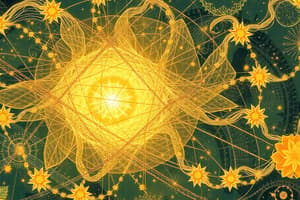Podcast
Questions and Answers
What is the relationship described by Newton's Second Law of Motion?
What is the relationship described by Newton's Second Law of Motion?
- Mass is the rate of change of force.
- Acceleration is independent of mass.
- Force is inversely proportional to acceleration.
- Force equals mass times acceleration. (correct)
Which of the following statements correctly defines kinetic energy?
Which of the following statements correctly defines kinetic energy?
- Energy produced by mechanical waves.
- Energy possessed due to an object's motion. (correct)
- Energy transferred through electromagnetic waves.
- Energy stored due to an object's position.
What does the First Law of Thermodynamics state?
What does the First Law of Thermodynamics state?
- Entropy in an isolated system can decrease over time.
- Energy can be created or destroyed in an isolated system.
- Energy flow is always directional and cannot reverse.
- Energy can be transformed but not created or destroyed. (correct)
Which phenomenon illustrates wave-particle duality in quantum mechanics?
Which phenomenon illustrates wave-particle duality in quantum mechanics?
Which option correctly describes potential energy?
Which option correctly describes potential energy?
What does Maxwell’s Equations pertain to?
What does Maxwell’s Equations pertain to?
Which of the following best describes General Relativity?
Which of the following best describes General Relativity?
What is the unit of measurement for force in the International System of Units (SI)?
What is the unit of measurement for force in the International System of Units (SI)?
किस सिद्धांत का प्रयोग वस्तुओं के गति के संदर्भ में समय और लंबाई के संकुचन को समझाने के लिए किया जाता है?
किस सिद्धांत का प्रयोग वस्तुओं के गति के संदर्भ में समय और लंबाई के संकुचन को समझाने के लिए किया जाता है?
थर्मोडायनामिक्स का कौन सा नियम यह बताता है कि एक अलगावित प्रणाली की एन्ट्रोपी हमेशा बढ़ती है?
थर्मोडायनामिक्स का कौन सा नियम यह बताता है कि एक अलगावित प्रणाली की एन्ट्रोपी हमेशा बढ़ती है?
न्यूटन के गति के नियमों में से एक का किससे संबंध है?
न्यूटन के गति के नियमों में से एक का किससे संबंध है?
वैज्ञानिकों ने किस बल को परिमाण (magnitude) के आधार पर सबसे मजबूत माना है?
वैज्ञानिकों ने किस बल को परिमाण (magnitude) के आधार पर सबसे मजबूत माना है?
क्वांटम यांत्रिकी में कौन सा सिद्धांत कणों के तरंग-भागीदार व्यवहार का वर्णन करता है?
क्वांटम यांत्रिकी में कौन सा सिद्धांत कणों के तरंग-भागीदार व्यवहार का वर्णन करता है?
मैग्नेट और इलेक्ट्रिक चार्ज के बीच संबंध का वर्णन करने वाली समीकरणों का समूह क्या कहलाता है?
मैग्नेट और इलेक्ट्रिक चार्ज के बीच संबंध का वर्णन करने वाली समीकरणों का समूह क्या कहलाता है?
SI इकाइयों में ऊर्जा को किस इकाई में मापा जाता है?
SI इकाइयों में ऊर्जा को किस इकाई में मापा जाता है?
किस बल को द्रव्यमान के बीच आकर्षण का कारण माना जाता है?
किस बल को द्रव्यमान के बीच आकर्षण का कारण माना जाता है?
Flashcards are hidden until you start studying
Study Notes
Physics
-
Definition: The branch of science concerned with the nature and properties of matter and energy.
-
Key Concepts:
- Force: An interaction that changes the motion of an object (measured in Newtons).
- Mass: A measure of the amount of matter in an object (measured in kilograms).
- Acceleration: The rate of change of velocity of an object (measured in m/s²).
-
Laws of Motion:
- Newton's First Law: An object at rest will stay at rest, and an object in motion will stay in motion unless acted upon by a net external force.
- Newton's Second Law: F = ma (the force acting on an object is equal to the mass of that object times its acceleration).
- Newton's Third Law: For every action, there is an equal and opposite reaction.
-
Energy:
- Kinetic Energy: Energy possessed by an object due to its motion; calculated as KE = 1/2 mv².
- Potential Energy: Energy stored in an object due to its position; calculated as PE = mgh (where g is the acceleration due to gravity).
-
Thermodynamics:
- First Law: Energy cannot be created or destroyed, only transformed.
- Second Law: The total entropy of an isolated system can never decrease over time.
-
Waves:
- Types: Mechanical (require a medium) and Electromagnetic (do not require a medium).
- Properties: Wavelength, frequency, amplitude, speed.
-
Electromagnetism:
- Relationship between electricity and magnetism: Moving electric charges produce magnetic fields.
- Maxwell’s Equations: Set of four fundamental equations that describe how electric and magnetic fields interact.
-
Quantum Mechanics:
- Wave-Particle Duality: Particles like electrons exhibit properties of both particles and waves.
- Uncertainty Principle: It is impossible to simultaneously know both the position and momentum of a particle with absolute precision.
-
Relativity:
- Special Relativity: Formulated by Einstein; states that the laws of physics are the same for all observers in uniform motion and introduces the concept that the speed of light is constant.
- General Relativity: Proposes that gravity is a curvature of spacetime caused by mass.
-
Applications of Physics:
- Engineering: Application of physical principles in the design and construction of structures, machines, and systems.
- Technology: Development of devices like lasers, semiconductors, and telecommunications based on physical principles.
Physics
- Definition: The study of matter and energy, and how they interact.
- Key Concepts:
Force
- An interaction that changes an object's motion.
- Measured in Newtons (N).
Mass
- The amount of matter in an object.
- Measured in kilograms (kg).
Acceleration
- The rate of change of an object's velocity.
- Measured in meters per second squared (m/s²).
Laws of Motion
- Newton's First Law: Objects at rest stay at rest, and objects in motion stay in motion at a constant velocity unless acted upon by a net force.
- Newton's Second Law: Force (F) equals mass (m) times acceleration (a) (F = ma).
- Newton's Third Law: For every action, there is an equal and opposite reaction.
Energy
- Kinetic Energy: Energy of motion; calculated as KE = 1/2 mv², where m is mass and v is velocity.
- Potential Energy: Stored energy due to position; calculated as PE = mgh, where m is mass, g is the acceleration due to gravity, and h is height.
Thermodynamics
- First Law: Energy can't be created or destroyed, only transformed.
- Second Law: The total entropy of an isolated system always increases over time.
Waves
- Types: Mechanical waves require a medium to travel (like sound); electromagnetic waves do not (like light).
- Properties: Wavelength (distance between crests), frequency (waves per second), amplitude (height of wave), and speed.
Electromagnetism
- Moving electric charges produce magnetic fields.
- Maxwell's Equations: Four fundamental equations describing the interaction of electric and magnetic fields.
Quantum Mechanics
- Wave-Particle Duality: Particles like electrons can behave as both particles and waves.
- Uncertainty Principle: It's impossible to know both the exact position and momentum of a particle at the same time.
Relativity
- Special Relativity: The laws of physics are the same for all observers in uniform motion, and the speed of light is constant.
- General Relativity: Gravity is a curvature in spacetime caused by mass.
Applications of Physics
- Engineering: Applying physics principles to design and build structures, machines, and systems.
- Technology: Developing devices like lasers, semiconductors, and telecommunications systems.
Studying That Suits You
Use AI to generate personalized quizzes and flashcards to suit your learning preferences.




